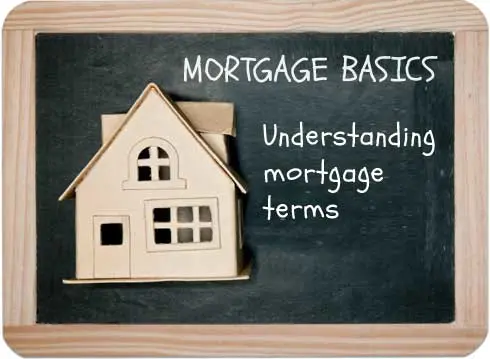- Getting a mortgage loan is a complicated process.
- Learn about different interest rates, payment schedules and other financial terms of a mortgage loan.
- Read about other basic mortgage terms dealing with credit and house value.
Your First Steps to Understanding & Getting a Mortgage
Editor’s Note
To help you be a more informed shopper, take the time to read a few articles about mortgage basics. This is the first article in a three part series. Read them all so that you make smart choices in your home loan!
- The Basic Terms: Payment Schedules, Interest Rates and Fees
- Credit Criteria: Credit Scores, Credit History, and Income Criteria
- House Value and LTV: Down-payment and Equity
Buying a house is a big investment, perhaps the single biggest purchase you will make. Very few of us can write out a check for the entire cost of a house. Fortunately, we don’t have to, because lenders offer mortgage loans.
A lender focuses on two main criteria when deciding whether you qualify for a mortgage loan:
- Your creditworthiness: The lender checks both your willingness to pay and your ability to pay, including:
- Your credit score and credit history: A predictive statistic to help determine how risky it is to offer you a loan. Credit score and history not only determine if you qualify for the loan, but also affect your loans's interest rate.
- Your income and monthly debt expenses: Evaluates your capability to make your payments.
- Your LTV (loan-to-value ratio): When you purchase a house, your lender looks at the size of your down-payment. If you are refinancing, it looks at how much equity you have, comparing your home's fair-market value to the size of your new loan.
Mortgage loans are complicated financial products. They involve long-term contracts, large sums of money, and confusing financial jargon. You will need to choose between different mortgage offers that include different durations, interest rates, fees and payment schedules. To get a mortgage loan at the best terms, it is crucial that educate yourself and then shop around.
Buying a Home?
Check out Bills.com Mortgage Affordability Calculator. Refinancing? Check out Bills.com Mortgage Refinance Tool.
The Basic Terms: Payment Schedules, Interest Rates and Fees
Before you start shopping for a mortgage loan, familiarize yourself with the key terms you'll encounter.
Mortgage Basics: Interest Rates

Your interest rate is the basic financial cost of the loan. Interest rates are quoted in annual terms, for example a 30-year mortgage at 3.5%. (2013 is starting off with mortgage interest rates near their all-time low). There are two types of interest rates:
- Fixed: Fixed interest rates are very popular when interest rates are low. With a fixed rate, you always know how much your payment will be.
- Variable or ARM (Adjustable Mortgage Rate): An ARM interest rate is tied to an index (like a treasury bond or the LIBOR rate) with an added margin. An ARM has an initial period where the interest rate is fixed. Afterward, the rate fluctuates in constant intervals. For example a 5/1 ARM has an initial fixed period of 5 years and then the rate is adjusted every 1 year. Arms come with caps and ceilings that limit the amount the interest rate can go up (and down) in one adjustment and for the life of the loan. ARMs are more complicated than fixed-rate loans and it is often hard to measure the risks of ARMs.
Lenders are required by law to include your loan fees into your quoted interest rate and provide you with an APR (Annual Percentage Rate). Be aware that it is hard to compare the many types of loans available based only on their different APRs. Compare the costs of mortgage loans based on mortgage rates and mortgage fees over the time you are considering holding on to the loan.
Find Up-to-the-Minute Home Loan Rates
For today’s rates, see Bills.com home loan rates table. Included with the rates are contact numbers to reach lenders directly.
Mortgage Basics: Mortgage Fee

Mortgage Loans come with many different types of fees, including:
- Lender fees: Application fee, origination fee and discount fees.
- Third party fees: Appraisal, title search and title insurance.
- Escrow fees and pre-paid: Property tax and property insurance.
Make sure that you understand the different types of fees. Your lender is obligated by law to provide you with an estimate of all the fees. In the early stages of your shopping, focus on the lender fees that affect the real financial costs of your loan.
Mortgage Basics: Payment Schedule

Most mortgage loans have a constant payment schedule with the same sized monthly mortgage payment as long as you hold the loan. Payments on ARMs fluctuate, due to changes in interest rates. There are also special types of mortgage payments, for borrowers with unique financial situations. One example is an Interest-Only (I/O) loan, which usually has an initial, specified time where you pay only interest on your loan balance, followed by regular principal and interest payments. Other examples of loans with unusual payment schedules include balloon payment loans and negative amortization loans. Anytime you are offered a non-standard mortgage loan, make sure that you clearly understand the payment schedule and the risks involved.
Principal
The amount of money you borrow. It can also refer to the balance, or the amount of money you owe the lender at any given time.
Term
The length of your mortgage loan is set to last is sometimes referred to as the "term." Mortgage loans vary between short-term loans (4 years) to long-term (40 years). The most common purchase loan is for a 30-year term. Many refinance loans are for 15-year terms.
Monthly Payment
Your monthly payment consists of two parts, principal and interest. The principal part of the payment reduces the amount of money you owe. The interest part declines over the period of the loan, if your interest rate is fixed. Use the Bills.com mortgage payment calculator to see how the size of your monthly mortgage payment will differ, based on different loan amounts, length of the loan term, and/or interest rates.
Other Payments
Besides the principal and interest, you may have other payments to make. Mortgage Insurance is common for borrowers whose loan is more than 80% of the value of the house. Another type of payment is your property tax and property insurance payments, which are often paid into a special, escrow account along with your principal and interest payment. If you are paying them on your own, it is important to make those payments on time. For condominium owners there are Home Owners Association (HOA) fees that you must make on time or risk problems with the HOA that can jeopardize your residence.
Mortgage Basics: Understanding your Loan
Getting a mortgage loan is a lengthy process that takes time and patience. If you come across a mortgage term you don't understand, then ask! Make sure your loan officer explains to you how your loan works and if any changes can raise your payments.
Make sure you understand the basic mortgage terms covering your interest rate, payments, and fees. Keep reading, to learn about creditworthiness (credit scores and debt-to-income ratios) and loan-to-value ratios, other important mortgage basics that affect you qualifying for a loan and how much your loan will cost.
Get a Home Loan Quote Fast
When you are ready to shop for a mortgage, get a mortgage quote from a bills.com home loan and refinance partner.
The mortgage market: what's new?
It is expected that mortgage rates are subject to change. Homebuyers and those refinancing their mortgages should pay close attention to the latest mortgage rate
Mortgage rates April 10, 2024
According to Freddie Mac, the 30-year mortgage rate for the week of April 10, 2024 stands at 6.88%. This reflects a 6 basis points increase from the previous week's rate.
Note: A basis point is equal to one-hundredth of one percent (0.01%). In numerical terms, if the mortgage rate changes by 20 basis points, it means the rate has changed by 0.20%.
Additionally, Freddie Mac reports that the 15-year mortgage rate for April 10, 2024 is 6.16%, indicating a 10 basis points increase from last week’s rates.
Understanding the impact of mortgage rates on your finances
When it comes to determining your monthly payment, mortgage rates are a key factor to consider. Here are the avergage interest rates (APR) for April 14, 2024 based on Zillow data for borrowers with a high credit score (680-740) in the United States:
- 30-year conventional loan is 7.09%
- 15-year conventional loan is 6.29%
Based on the provided rates, a $279,082 30-year mortgage would result in a monthly payment of $1,874. Alternatively, a 15-year mortgage would require a monthly payment of around $2,399.
Explore your options and secure pre-approval today!
To make your life easier, we highly recommend shopping around for mortgages and getting pre-approved. This will streamline the home-buying or refinancing process and make it a breeze. Ready to get started? Check Out mortgage rates now for the best options available.
